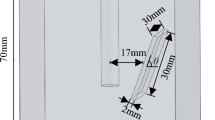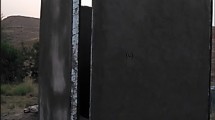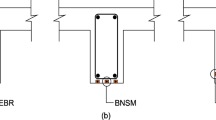Abstract
Ultrasonic Echo Tomography (UET) technology has been used as a tool to assess the condition of hardened cementitious concrete by detecting possible subsurface anomalies such as honeycombing, delamination, and air-pocket. In this study, the performance of UET was evaluated in a laboratory study and in three field case studies. In the laboratory, a concrete slab specimen was prepared with manmade honeycombing, delamination, and voids. Steel reinforcing bars with different diameters and a nonmetallic pipe were pre-embedded in the concrete slab. The three field case studies involved evaluating structural beams, a reinforced concrete floor slab, and some reinforced concrete walls constructed with normal-weight concrete. Based on the limited information obtained in this study, it was determined that significant honeycombing, cracks, delamination, and backside of the concrete member formed interfaces with the concrete matrix that could significantly reflect ultrasonic waves. These subsurface objects were clearly imaged by UET at a greater depth from the concrete surface of scanning. Steel reinforcing bars and cluster of small voids formed interfaces with the concrete matrix that could reflect a small amount of ultrasonic wave. These subsurface objects could not be imaged due to attenuation if they were located too deep from the concrete surface. For subsurface objects located close to the concrete surface in a porous concrete matrix, they might not be imaged due to the increased attenuation of ultrasonic waves. A gap in the backside reflection could indicate the presence of subsurface objects that could not be observed in a UET image. Needs for future research were proposed in this study.



















Similar content being viewed by others
References
Alver N, Wiggenhauser H (2010) Modified SIBIE procedure for ungrouted tendon ducts applied to scanning impact-echo. Constr Build Mater 24(12):2388–2392. https://doi.org/10.1016/j.conbuildmat.2010.05.012
Aggelis D, Shiotani T (2007) Repair evaluation of concrete cracks using surface and through-transmission wave measurements. Cem Concr Compos 29(9):700–711. https://doi.org/10.1016/j.cemconcomp.2007.05.001
Beutel R et al (2008) Comparative performance tests and validation of NDT methods for concrete testing. J Nondestruct Eval 27:59–65. https://doi.org/10.1007/s10921-008-0037-1
Hassan A, Jones S (2012) Non-destructive testing of ultra high performance fibre reinforced concrete (UHPFRC): a feasibility study for using ultrasonic and resonant frequency testing techniques. Constr Build Mater 35:361–367. https://doi.org/10.1016/j.conbuildmat.2012.04.047
Ferraro C, Boyd A, Hamilton H (2007) Detection and assessment of structural flaws in concrete bridges with NDT methods. Res Nondestr Eval 18(3):179–192. https://doi.org/10.1080/09349840701378762
Krause M et al (1997) Comparison of pulse-echo methods for testing concrete. NDT E Int 30(4):195–204. https://doi.org/10.1016/S0963-8695(96)00056-4
Lim M, Cao H (2013) Combining multiple NDT methods to improve testing effectiveness. Constr Build Mater 38:1310–1315. https://doi.org/10.1016/j.conbuildmat.2011.01.011
Popovics J, Rose J (1994) A survey of developments in ultrasonic NDE of concrete. IEEE Transact Ultrason Ferroelectr Freq Control 41(1):140–143. https://doi.org/10.1109/58.265832
Haza A, Samokrutov A, Samokrutov P (2013) Assessment of concrete structures using the Mira and Eyecon ultrasonic shear wave devices and the SAFT-C image reconstruction technique. Constr Build Mater 38:1276–1291. https://doi.org/10.1016/j.conbuildmat.2011.06.002
Rahiman M et al. (2012) Design and development of ultrasonic process tomography. IntechOpen Limited. pp 211–215. https://www.intechopen.com/books/ultrasonic-waves/design-and-development-of-ultrasonic-process-tomography. Accessed 31 Mar 2020
Kim B-C, Kim J-Y (2009) Characterization of ultrasonic properties of concrete. Mech Res Commun 36(2):207–214. https://doi.org/10.1016/j.mechrescom.2008.07.003
Berthaud Y (1991) Damage measurements in concrete via an ultrasonic technique. Part I experiment. Cem Concr Res 21(1):3–82. https://doi.org/10.1016/0008-8846(91)90033-E
Schubert F, Köhler B (2001) Three-dimensional time domain modeling of ultrasonic wave propagation in concrete in explicit consideration of aggregates and porosity. J Comput Acoust 9(04):1543–1560. https://doi.org/10.1142/S0218396X01000978
Shevaldykin V, Samokrutov A, Kozlov V (2002) Ultrasonic low-frequency transducers with dry dot contact and their applications for evaluation of concrete structures. In: 2002 IEEE ultrasonics symposium, IEEE, Munich. https://doi.org/10.1109/ULTSYM.2002.1193518
Cheeke J (2016) Fundamentals and applications of ultrasonic waves. CRC Press, Boca Raton
Nazarchuk Z, Skalskyi V, Serhiyenko O (2017) Acoustic emission: methodology and application. Springer, Berlin. https://doi.org/10.1007/978-3-319-49350-3
Popovics S et al (2000) High-frequency ultrasound technique for testing concrete. ACI Mater J 97(1):58–65
Hendee W, Ritenour E (2003) Medical imaging physics. Wiley, Hoboken
Beniwal S, Ghosh D, Ganguli A (2016) Ultrasonic imaging of concrete using scattered elastic wave modes. NDT E Int 82:26–35. https://doi.org/10.1016/j.ndteint.2016.04.003
Krause M et al (2008) Ultrasonic imaging methods for investigation of post-tensioned concrete structures: a study of interfaces at artificial grouting faults and its verification. J Nondestruct Eval 27:67–82. https://doi.org/10.1007/s10921-008-0033-5
Matsuyama K et al (2010) On-site measurement of delamination and surface crack in concrete structure by visualized NDT. Constr Build Mater 24(12):2381–2387. https://doi.org/10.1016/j.conbuildmat.2010.05.011
Schickert M (2005) Progress in ultrasonic imaging of concrete. Mater Struct 38(9):807–815. https://doi.org/10.1007/BF02481653
Choi P et al (2016) Application of ultrasonic shear-wave tomography to identify horizontal crack or delamination in concrete pavement and bridge. Constr Build Mater 121:81–91. https://doi.org/10.1016/j.conbuildmat.2016.05.126
Hoegh K, Khazanovich L, Yu H (2012) Concrete pavement joint diagnostics with ultrasonic tomography. Transp Res Rec 2305:54–61. https://doi.org/10.3141/2305-06
Alani A, Tosti F (2018) GPR applications in structural detailing of a major tunnel using different frequency antenna systems. Constr Build Mater 158:1111–1122. https://doi.org/10.1016/j.conbuildmat.2017.09.100
Capozzoli L, Rizzo E (2017) Combined NDT techniques in civil engineering applications: laboratory and real test. Constr Build Mater 154:1139–1150. https://doi.org/10.1016/j.conbuildmat.2017.07.147
ASTM (2015) C143 standard test method for slump of hydraulic-cement concrete. ASTM, West Conshohocken
ASTM (2018) C39 standard test methods for compressive strength of cylindrical concrete specimens. ASTM, West Conshohocken
Li Z, Rangaraju PR (2015) Effect of sand content on properties of self-consolidating, high-performance cementitious mortar. Transp Res Rec 2508:84–92. https://doi.org/10.3141/2508-11
Li Z (2017) Predicting the drying shrinkage behavior of high strength portland cement mortar under the combined influence of fine aggregate and steel micro fiber. Mater Constr 67(326):119. https://doi.org/10.3989/mc.2017.05916
Wille K, Naaman A, Parra-Montesinos G (2011) Ultra-high performance concrete with compressive strength exceeding 150 MPa (22 ksi): a simpler way. ACI Mater J 108(1):46–54
Wille K et al (2012) Ultra-high performance concrete and fiber reinforced concrete: achieving strength and ductility without heat curing. Mater Struct 45(3):309–324. https://doi.org/10.1617/s11527-011-9767-0
Li Z (2016) Drying shrinkage prediction of paste containing meta-kaolin and ultrafine fly ash for developing ultra-high performance concrete. Mater Today Commun 6:74–80. https://doi.org/10.1016/j.mtcomm.2016.01.001
Funding
Not applicable.
Author information
Authors and Affiliations
Contributions
This manuscript is based on the author’s hand-on project experience with UET. He is the only author who is responsible for the accuracy of data, discussions, and conclusions presented in the manuscript. The information included in the manuscript has never been published before.
Corresponding author
Ethics declarations
Conflict of interest
The author, myself, certify that there are No affiliations with or involvement in any organization or entity with any financial interest (such as honoraria; educational grants; participation in speakers’ bureaus; membership, employment, consultancies, stock ownership, or other equity interest; and expert testimony or patent-licensing arrangements), or non-financial interest (such as personal or professional relationships, affiliations, knowledge or beliefs) in the subject matter or materials discussed in this manuscript.
Additional information
Publisher's Note
Springer Nature remains neutral with regard to jurisdictional claims in published maps and institutional affiliations.
Rights and permissions
About this article
Cite this article
Li, Z. A study on ultrasonic echo tomography for non-destructive evaluation of hardened cementitious concrete. J Build Rehabil 5, 13 (2020). https://doi.org/10.1007/s41024-020-00079-x
Received:
Accepted:
Published:
DOI: https://doi.org/10.1007/s41024-020-00079-x




